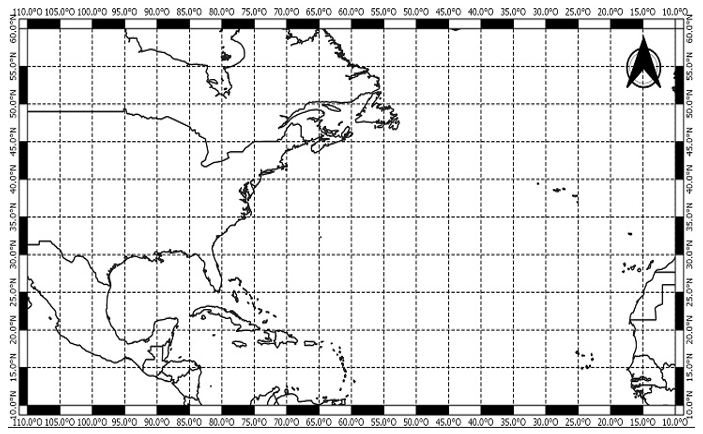Variability of the North Atlantic Subtropical High during the months of November to April from 1950 to 2019
Main Article Content
Abstract
The North Atlantic Subtropical High predominates over a very wide region of the northern hemisphere and is a fundamental system of the general circulation of the atmosphere. It is considered a governing system of the meteorological systems in the Atlantic basin and therefore it intervenes in the behavior of tropical systems. Therefore, the present work aims to characterize and analyze its variability. The monthly database of the National Center for Environmental Prediction and the National Center for Atmospheric Research of the United States Oceanic and Atmospheric Administration was consulted for the months of November to April 1950-2019. The central pressure of the subtropical high at the surface was determined from the value of the closed isobar closest to the center and by means of this; its mean position was estimated. Another element analyzed at the surface was its strength, based on the average position it occupies during the low rainfall period of the year. On the other hand, the value of the geopotential and the position of the high center at 850 hPa and the geopotential at 500 hPa and 200 hPa were obtained and analyzed, since these are representative levels of the atmospheric circulation in the lower and middle troposphere. The results showed that the North Atlantic Subtropical High has presented few morphological variations; however, it has modified its intensity and has shifted to the east-northeast with respect to its average position.
Downloads
Article Details

This work is licensed under a Creative Commons Attribution-NonCommercial 4.0 International License.
Those authors who have publications with this journal accept the following terms of the License Attribution-NonCommercial 4.0 International (CC BY-NC 4.0):
You are free to:
- Share — copy and redistribute the material in any medium or format
- Adapt — remix, transform, and build upon the material
The licensor cannot revoke these freedoms as long as you follow the license terms.
Under the following terms:
- Attribution — You must give appropriate credit, provide a link to the license, and indicate if changes were made. You may do so in any reasonable manner, but not in any way that suggests the licensor endorses you or your use.
- NonCommercial — You may not use the material for commercial purposes.
- No additional restrictions — You may not apply legal terms or technological measures that legally restrict others from doing anything the license permits.
The journal is not responsible for the opinions and concepts expressed in the works, they are the sole responsibility of the authors. The Editor, with the assistance of the Editorial Committee, reserves the right to suggest or request advisable or necessary modifications. They are accepted to publish original scientific papers, research results of interest that have not been published or sent to another journal for the same purpose.
The mention of trademarks of equipment, instruments or specific materials is for identification purposes, and there is no promotional commitment in relation to them, neither by the authors nor by the publisher.
References
Ballester, M., González, C., & Pérez, R. (2004). Modelo estadístico para el pronóstico de la actividad ciclónica en el océano Atlántico, el golfo de méxico y el mar Caribe. Revista Cubana de Meteorología, 11(1), 84-92.
Ballester, M., González, C., & Pérez, R. (2010). Variabilidad de la actividad ciclónica en la región del Atlántico Norte y su pronóstico. Editorial Academia.
Centella, A., Lapinel, B., Solano, O., Vázquez, R., Fonseca, C., Cutié, V., Baéz, R., González, S., Sille, J., & Rosario, P. (2006). La sequía meteorológica y agrícola en la República de Cuba y la República Dominicana. Programa de Desarrollo de las Naciones Unidas (PNUD.
Cherchi, A., Ambrizzi, T., Behera, S., Freitas, A. C. V., Morioka, Y., & Zhou, T. (2018). The response of subtropical highs to climate change. Current Climate Change Reports, 4(4), 371-382. https://doi.org/10.1007/s40641-018-0114-1
Davis, R. E., Hayden, B. P., Gay, D. A., Phillips, W. L., & Jones, G. V. (1997). The north atlantic subtropical anticyclone. Journal of Climate, 10(4), 728-744. https://doi.org/10.1175/1520-0442(1997)010<0728:TNASA>2.0.CO;2
Fonseca, C. (2005). Cambios en la posición e intensidad del anticiclón del Atlántico y modificación en el régimen de las lluvias en Cuba. Revista Cubana de Meteorología, 12(2), 25-34.
GRADS. (2018). Grid Analysis and Display System (1.7) [Windows]. http://grads.iges.org/grads/dowloads.html.
Hasanean, H. M. (2004). Variability of the North Atlantic subtropical high and associations with tropical sea‐surface temperature. International Journal of Climatology: A Journal of the Royal Meteorological Society, 24(8), 945-957. https://doi.org/10.1002/joc.1042
Kalnay, E., Kanamitsu, M., Kistler, R., Collins, W., Deaven, D., Gandin, Lev, Iredell, Mark, Saha, Suranjana, White, Glenn, Woollen, John, & others. (1996). The NCEP/NCAR 40-Year Reanalysis Project. Bulletin of the American meteorological Society, 77(3), 437-472. https://doi.org/10.1175/1520-0477(1996)077<0437:TNYRP>2.0.CO;2
Lecha, L. B., Lapinel, B., & Paz, L. R. (1994). El Clima de Cuba. Academia.
Luchetti, N. T., Nieto Ferreira, R., Rickenbach, T. M., Nissenbaum, M. R., & McAuliffe, J. D. (2017). Influence of the North Atlantic Subtropical High on wet and dry sea-breeze events in North Carolina, United States. University of Alicante, 68, 9-25.
Mellado, E., & Borrajero, I. (1997). Winstat (2.0 (beta)) [Window].
Pérez, R., Fonseca, C., B. Lapinel, C. González, Planos, E., V. Cutié, & R. Vega. (2009). Actualización del conocimiento sobre variaciones, cambios y tendencias del clima en Cuba (Segunda Comunicación de Cuba a la Convención Marco de Naciones Unidas Sobre Cambio Climático, p. 62) [Informe de Resultado Científico]. Instituto de Meteorología.
Sneyers, R. (1990). On the statistical analysis of series of observations (Technical Note No 143 WMO No415; p. 192). World Meteorological Organization

